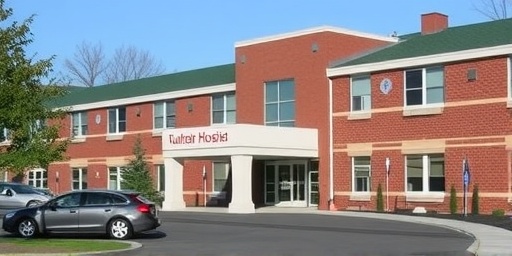In a landmark move for Vermont healthcare regulation, the Green Mountain Care Board (GMCB) has launched a formal review to potentially block Rutland Regional Medical Center’s plan to shutter its inpatient pediatric unit. This intervention marks the inaugural application of a transformative new state law designed to prevent hospital service cuts that could jeopardize patient access to critical care, especially for children in rural areas.
- Rutland Regional Cites Finances for Pediatric Unit Shutdown
- New Vermont Law Arms Regulators Against Harmful Service Cuts
- Green Mountain Care Board Kicks Off Intensive Review Hearings
- Parents, Providers Rally Against Pediatric Care Gaps in Vermont
- Future of Vermont Pediatrics Hinges on Regulatory Outcome
The decision comes amid growing concerns over dwindling pediatric services in Vermont, where Rutland Regional—one of the state’s key hospitals—handles around 300 pediatric admissions annually. Hospital officials cited financial pressures and low utilization rates as reasons for the closure, but regulators argue the move could force families to travel hours for pediatrics care, exacerbating Vermont‘s rural healthcare challenges.
Rutland Regional Cites Finances for Pediatric Unit Shutdown
Rutland Regional Medical Center, a 699-bed facility serving southern and central Vermont, announced its intent to close the 12-bed inpatient pediatric unit in late 2023. Hospital CEO Sarah Johnson explained in a public statement that the unit operates at just 25% capacity on average, generating annual losses exceeding $2.5 million due to staffing shortages and declining birth rates across the state.
“We’ve explored every option to sustain these services, but the economics simply don’t add up in today’s reimbursement environment,” Johnson said during a community forum last month. The hospital plans to redirect pediatric patients to outpatient services or transfer them to larger facilities like the University of Vermont Medical Center in Burlington, over 70 miles away.
Statistics underscore the strain: Vermont’s pediatric hospitalization rates have dropped 15% since 2019, per state health department data, mirroring national trends post-COVID. Yet, Rutland Regional remains a lifeline for the Rutland County region, where 20% of the population is under 18, and ambulance response times to alternative hospitals can exceed 90 minutes in winter conditions.
- Annual pediatric admissions at Rutland: ~300 (down from 450 pre-pandemic)
- Unit staff: 45 full-time equivalents, facing 20% vacancy rates
- Projected savings from closure: $3 million annually
Critics, including local pediatricians, warn that even outpatient redirection isn’t feasible for severe cases like respiratory distress or trauma, common in pediatrics.
New Vermont Law Arms Regulators Against Harmful Service Cuts
At the heart of the GMCB’s intervention is Act 54, a 2023 Vermont law that revolutionized healthcare regulation by granting the board explicit authority to veto hospital proposals for closing or downgrading “essential services.” Defined as units providing care to vulnerable populations—like pediatrics—these services now require GMCB approval if closure could “materially harm patient access.”
Sponsored by Sen. Ginny Buchanan (D-Essex), the legislation passed with bipartisan support amid outcry over prior service cuts at facilities like Northeastern Vermont Regional Hospital, which axed obstetrics in 2021. “Vermont families shouldn’t lose bedside care because spreadsheets say so,” Buchanan stated in a recent interview. The law mandates a multi-step review: public hearings, impact assessments, and alternatives analysis.
This is the first real-world test. GMCB Chair Jessica Holmes emphasized, “We’re not here to micromanage hospitals, but to ensure Vermonters retain access to lifesaving pediatric services. Rutland’s proposal triggers our highest scrutiny level.” The board, established in 2011 to control healthcare costs, has previously approved mergers but rarely blocked service changes outright.
Key Provisions of Act 54
- Requires hospitals to submit 180-day notices for major service cuts.
- GMCB must evaluate geographic access, patient outcomes, and equity impacts.
- Hospitals bear the burden of proving no viable alternatives exist.
- Penalties for non-compliance: fines up to $500,000 or mandated service restoration.
Advocates hail it as a bulwark against rural hospital consolidations, while hospital lobbies like the Vermont Association of Hospitals and Health Systems decry it as added bureaucracy amid 7% operating margins statewide.
Green Mountain Care Board Kicks Off Intensive Review Hearings
The GMCB initiated its review on October 15, 2024, scheduling virtual and in-person hearings through December. Over 200 public comments have flooded in, with a petition from Rutland parents garnering 1,500 signatures urging the board to intervene.
During the first hearing, GMCB analysts presented preliminary data showing that closure could increase travel times for 85% of Rutland-area pediatric patients by at least 45 minutes. Independent experts from the Vermont Oxford Network testified on neonatal transfer risks, citing a 12% higher complication rate for transports over 50 miles.
Hospital representatives countered with a transition plan: partnering with UVMMC for telehealth consults and maintaining a pediatric emergency stabilization area. However, GMCB Vice Chair Kevin Mullin questioned its adequacy: “Telehealth can’t intubate a child in septic shock.”
The review docket includes:
- Economic viability audits by GMCB finance staff.
- Patient access modeling using GIS data.
- Stakeholder testimonies from physicians, EMS providers, and insurers.
A final decision is slated for January 2025, with potential orders to keep the unit open for up to two years while alternatives are developed.
Parents, Providers Rally Against Pediatric Care Gaps in Vermont
The proposed closure has ignited fierce backlash from Rutland families. “My 4-year-old spent three days here last winter with pneumonia—if this unit closes, we’d be driving through blizzards to Burlington,” said resident Emily Carter, whose online campaign #SaveRutlandPeds has 5,000 followers.
Dr. Maria Lopez, a Rutland pediatrician with 15 years at the hospital, voiced concerns: “We’re already short-staffed; losing inpatient beds means turning away kids or risking overcrowding in ERs. Vermont’s pediatric workforce is strained—only 120 board-certified pediatricians statewide for 65,000 kids.”
On the flip side, hospital board member Tom Reilly defended the move: “Redirecting resources to high-acuity areas like oncology and cardiology benefits more patients long-term.” Insurers like MVP Health Care support efficiencies but pledged $1 million in grants for rural pediatric transport if approved.
Vermont’s pediatric landscape is precarious: Just 10 hospitals offer inpatient pediatrics, with closures in Barre and St. Albans since 2010. Statewide, infant mortality rose 10% last year, per CDC data, heightening urgency.
Future of Vermont Pediatrics Hinges on Regulatory Outcome
If the GMCB blocks the closure, Rutland Regional could appeal to the Vermont Supreme Court, setting precedents for future service cuts. Success might embolden regulators to scrutinize other proposals, like Brattleboro Memorial’s labor and delivery review.
Broader implications loom for Vermont hospital finances: Medicaid reimbursement rates lag Medicare by 20%, fueling deficits. Lawmakers are eyeing federal grants from the 2021 infrastructure bill to bolster rural pediatrics.
Alternatives under discussion include regional pediatric hubs, nurse practitioner expansions, and school-based clinics. GMCB’s January ruling could redefine healthcare regulation in Vermont, balancing fiscal realities with child health imperatives. As hearings continue, all eyes are on Rutland—where a small unit’s fate could safeguard pediatric care for generations.
Stakeholders urge swift action: “This isn’t just about beds; it’s about Vermont kids getting care close to home,” Holmes reiterated. Updates will follow as the board deliberates.








